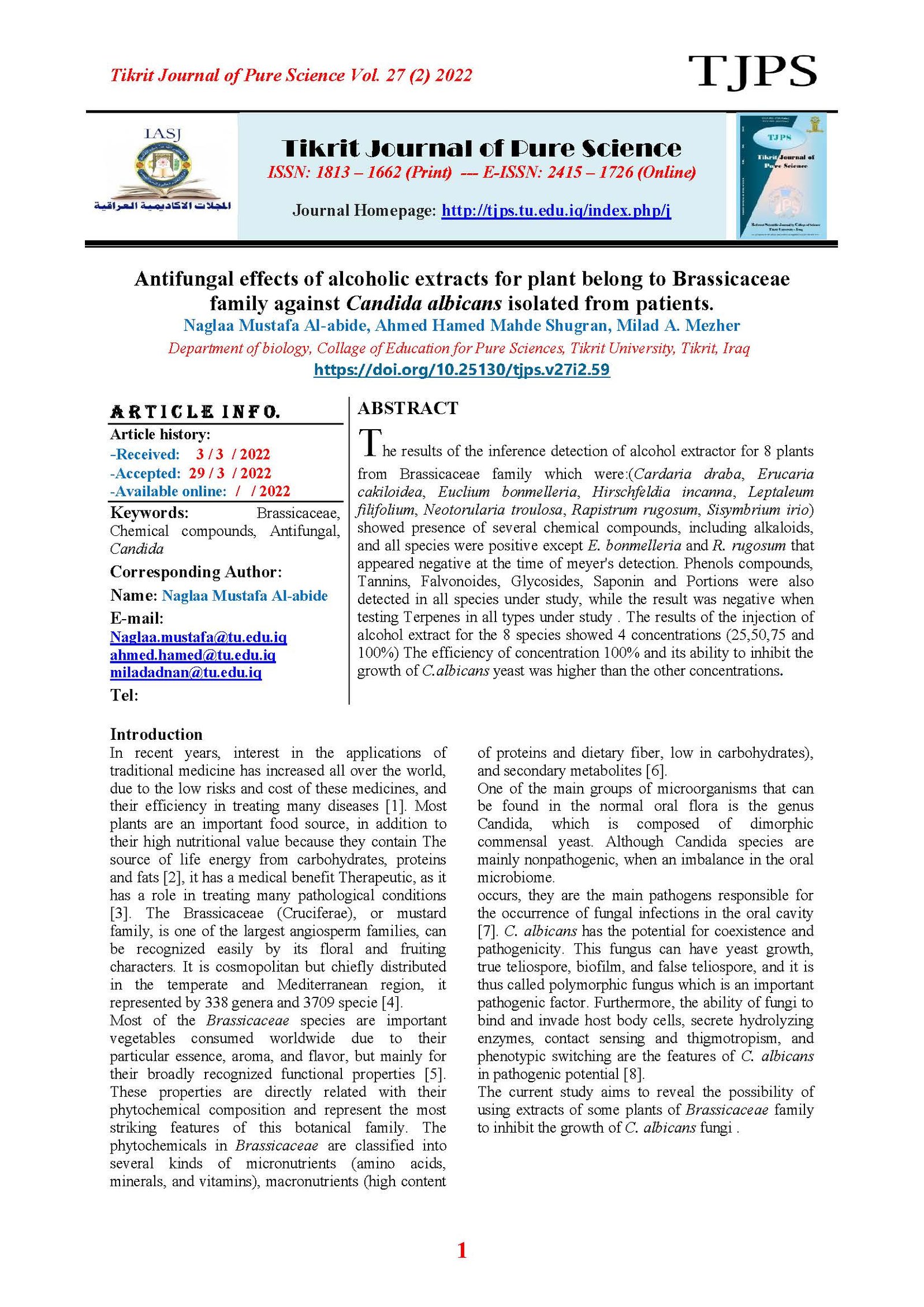Antifungal effects of alcoholic extracts for plant belong to Brassicaceae family against Candida albicans isolated from patients.
Main Article Content
Abstract
The results of the inference detection of alcohol extractor for 8 plants from Brassicaceae family which were:(Cardaria draba, Erucaria cakiloidea, Euclium bonmelleria, Hirschfeldia incanna, Leptaleum filifolium, Neotorularia troulosa, Rapistrum rugosum, Sisymbrium irio) showed presence of several chemical compounds, including alkaloids, and all species were positive except E. bonmelleria and R. rugosum that appeared negative at the time of meyer's detection. Phenols compounds, Tannins, Falvonoides, Glycosides, Saponin and Portions were also detected in all species under study, while the result was negative when testing Terpenes in all types under study . The results of the injection of alcohol extract for the 8 species showed 4 concentrations (25,50,75 and 100%) The efficiency of concentration 100% and its ability to inhibit the growth of C.albicans yeast was higher than the other concentrations
Article Details

This work is licensed under a Creative Commons Attribution 4.0 International License.
Tikrit Journal of Pure Science is licensed under the Creative Commons Attribution 4.0 International License, which allows users to copy, create extracts, abstracts, and new works from the article, alter and revise the article, and make commercial use of the article (including reuse and/or resale of the article by commercial entities), provided the user gives appropriate credit (with a link to the formal publication through the relevant DOI), provides a link to the license, indicates if changes were made, and the licensor is not represented as endorsing the use made of the work. The authors hold the copyright for their published work on the Tikrit J. Pure Sci. website, while Tikrit J. Pure Sci. is responsible for appreciate citation of their work, which is released under CC-BY-4.0, enabling the unrestricted use, distribution, and reproduction of an article in any medium, provided that the original work is properly cited.
References
[1] Jamzad, Z. (2013). A survey of Lamiaceae in the flora of Iran. Rostaniha, 14(1), 59-67.
[2] Khasawneh, F. E.; Sample, E. C. and Kamprath, E. J. (1980). The Role of Phosphorus in Agriculture, Print American Crop and Soil Science Society of America Inc. Madison, Wisconsin, USA.
[3] Aiyelaagbe, O. O., and Osamudiamen, P. M. (2009). Phytochemical screening for active compounds in Mangifera indica leaves from Ibadan, Oyo State. Plant Sci Res, 2(1), 11-13.
[4] Warwick, S. I., Francis, A., and Al-Shehbaz, I. A. (2006). Brassicaceae: species checklist and database on CD-Rom. Plant Systematics and Evolution, 259(2), 249-258.
[5] Aires, A. (2015). Brassica composition and food processing. In Processing and Impact on Active components in Food (pp. 17-25). Academic Press.
[6] Ramirez, D., Abellán-Victorio, A., Beretta, V., Camargo, A., and Moreno, D. A. (2020). Functional ingredients from Brassicaceae species: Overview and perspectives. International Journal of Molecular Sciences, 21(1998), 1–21.
[7] Baumgardner, D.J.(2019). Oral fungal microbiota: to thrush and beyond. Journal of Patient-Centered Research and Reviews, 6(4), 252.
[8] Naglik, J. R., Richardson, J. P., and Moyes, D. L. (2014). Candida albicans pathogenicity and epithelial immunity. PLoS pathogens, 10(8), e1004257.
[9] Townsend, C. C. and Guset , E.(1980).Flora of Iraq vol.4 part 1. Ministry of agriculture.
[10] Rechinger, K.H.(1972). Flora Iranica. 98:1-67.Akadimische Druck-u. Verlagsanstalt. Graz-Austria.
[11] Banso, A. and Adeyemo, S. (2006). Phytochemical screening and antimicrobial assessment of Abutilon mauritianum, Bacopa monnifera and Datura stramonium. Biokemistri1. 8(1): 39-44.
[12] Siddiqui, A. A., and Ali, M. (1997). Practical pharmaceutical chemistry. CBS Publishers and Distributors.
[3] Harborne, J.B.(1973). Textbook of phytochemical methods, 1st Edn, Champraan and Hall Ltd. London. pp, 110-113.
[14] Harborn, J.B. (1984). Phytochemical Methods Second edition. Chapman, Hall. New York. USA.
[15] AL-Khazaraji, S.M.(1991). Bio pharmacological Study of Artemisia herb. Ms.c. Thesis, College of pharmacy, Baghdad university. Iraq.
[16] Gibbs, R. D. (1974). Chemotaxonomy of flowering plants: four volumes. McGill-Queen's Press-MQUP.
[17] Shihata, I. M. (1951). A pharmalogical study of Anagllis arvensis. MD Vet (Doctoral dissertation, Thesis, Cairo University. 10).
[18] Tripathi, I. P., and Mishra, C. (2015). Phytochemical screening of some medicinal plants of Chitrakoot region. Indian Journal of Applied Research, 5(12), 56-60.
[19] Koneman E and Roberts GD.(1985) Practical Laboratory Mycology. 3rd. Wiliams and Wilkins, Baltimore, London.
[20] Jagdish C. (2009) Textbook of medical mycology. New Delhi, India: Meheta.
[21] Perez C, Paul M, Bazerque P. (1990) An antibiotic assay by the agar well diffusion method. Acta Biologiae et Medicinae Experimentalis. 15, 113-115.
[22] Amade P, Mallea M, Bouaicha N. (1994) Isolation, structural identification and biological activity of two metabolites produced by Penicillium olsoniibainier and Sartory. Journal of Antibiotics. 47,201-207.
[23] Favela‐González, K.M., Hernández‐Almanza, A.Y. and De la Fuente‐Salcido, N.M., 92020). The value of bioactive compounds of cruciferous vegetables (Brassica) as antimicrobials and antioxidants: A review. Journal of Food Biochemistry, 44(10), p.e13414.
[24] Fagade, O. E., and Oyelade, A. A. (2009). A comparative study of the antibacterial activities of some wood-decay fungi to synthetic antibiotic discs. Electron J Environ Agric Food Chem, 8, 184-188.
[25] Aydin, S. (2020). Total phenolic content, antioxidant, antibacterial and antifungal activities, FT-IR analyses of Brassica oleracea L. var. acephala and Ornithogalum umbellatum L. Genetika, 52(1), 229-244.
